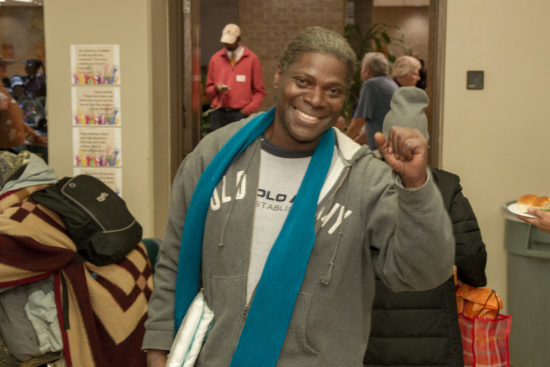Thermal Underwear Drive


View 2022 KXAN Coverage of this years event.
Every year, House the Homeless conducts a Thermal Underwear Drive to provide thermal underwear, hats, gloves, scarves, and ponchos for homeless men, women and children in Austin. The drive begins at the House the Homeless Memorial Service and concludes at the Thermal Underwear Party on New Year’s Day.
The 2012 drive resulted in more than 3,500 thermal tops, bottoms, scarves, hats, gloves, etc. that were handed out to more than 600 homeless men, women and children in Austin. Each year it gets bigger.
Please help keep some of Austin’s homeless men, women and children warm this winter by contributing to the Thermal Underwear Drive.
We welcome donations of any amount. We use the donations to buy in bulk to maximize what we can get.
$10 = one thermal top and one thermal bottom.
$35 = one thermal top, one thermal bottom, one hat, one pair of gloves, one scarf and one poncho.
So you can see how just a few dollars can make a big difference!
Click the button below to donate online!
Or, please send a check payable to House the Homeless, Inc to:
House the Homeless
P.O. Box 2312
Austin, TX 78768
Thank you for your never ending support for the folks living on our streets.
Together we can end homelessness.
Richard Troxell
Check out the Event
Even the Best Band-Aid Is No Cure
Last week, Richard R. Troxell of House the Homeless accepted the invitation from Austin’s CultureMap to contribute to a special editorial series called “Imagine Austin’s Future.” The best thing to do is just read “How to end homelessness in Austin: A plan”...
From Head to Toe
Here are a few excerpts from Doing It Homeless, the website created by Kendoll, an actor/Web designer who lives in his car in Los Angeles. His advice to other homeless men is, invest in electric clippers which, although a big-budget item to a pauper,...
How to Become Homeless: Have a Criminal Record
Who has time to read every newsletter? But when one shows up, headlined, “Why does the United States lock up so many people?,” attention must be paid. The answers are to be found in The New Yorker piece, by Adam Gopnik, called “The Caging of America.” Here are some of...
Richer Rich, Poorer Poor, and PSC
House the Homeless looked at the Associated Press journalist Hope Yen’s report on the recent Pew survey about attitudes concerning class in the United States. It turned out to be so interesting, there’s more to say about it. Increasing poverty...
Perceptions and Poverty
Associated Press reporter Hope Yen recently wrote about a telephone survey conducted by the Pew Research Center in December of 2011. More than 2,000 adults were questioned about class tensions, which researchers conclude are at their most intense in 25 years. The...
Looking Back at 2011
Amongst the year’s news research, one of the more interesting comments from the public to be discovered came from “pdquick,” who worked in the streets for years as a paramedic, and later as a doctor in a program for people experiencing homelessness. This...
Homeless in the Capitol of America
Eric Sheptock, the media-savvy “Homeless Homeless Advocate,” has posted a 14-minute video detailing the events of 2011 in Washington, D.C. He gives a little of the back-story of homeless activism in the nation’s capitol, especially the years-long battle for the...
Occupy Occupied — by People Experiencing Homelessness
The homeless community and the Occupy movement agree on many points: — The yawning chasm of wealth disparity is not to be tolerated.— People need jobs.— Corporate greed is at fault. (Maybe not all corporations. Greedy ones, definitely.)— Also guilty is the whole mess...
Occupy Homelessness
Barbara Ehrenreich published a very significant book called Nickel and Dimed: On (Not) Getting By in America. More recently, she pointed out the similarities between the Occupy political protesters and people experiencing homelessness, who both engage in...
Minimum Wage and the Rental Market
Big cities usually have apartment shortages. This is nothing new. But, nowadays, the prospective tenants come from a different demographic. Many of them are former (attempted) home buyers who couldn’t hold on. Some are people who, in a better economy, would be...


